On Day 12 of the March Slice of Life Challenge, I am celebrating 12 truths I have observed during Reading Workshop with my Grade 4 & 5 class this year. This is six months in with an intermediate classroom. Some of my learning is new. Some has been confirmed yet again.
- There needs to be daily time to read during class. If special events happen, a space for reading still needs to be found. This is non-negotiable.
- Reading culture is strengthened by peer recommendations, hype about popular books and a buzz about new titles. Readers need to be immersed in a reading culture. The contagion factor of book love is the most true thing of all when it comes to helping readers develop reading lives.
- “Just for you” matters. A book stack selected for a specific reader’s perusal is a bridge on the road to independent book selection. When I hold up a book to a child and say “This is a {insert child’s name here} book” I can almost guarantee they will read it.
- Provide lessons on book abandonment. Reiterate what you have said throughout the year. Support these choices. Smile as enthusiastically when the book goes back on the shelf unread as when a book is taken off the shelf to be read.
- Let there be too many books. Celebrate the overstuffed book box. Happily diagnose “book-lover-itis” disease. Let there be room for enthusiasm and then teach how to prioritize, how to read more than one book at a time and how to save some for later.
- Make sure there is a huge selection of books in your classroom library: books from all genres, short books, long books, books that are light and books that are heavy. Picture books matter. Nonfiction matters. Poetry matters. Graphics matter. I can look around the room and see one child reading Dory Fantasmagory by Abby Hanlon and another one reading A Night Divided by Jennifer A. Nielsen. A range of books sustains a range of readers with all kinds of moods, skills and interests.
- If a child is choosing books beyond his/her reading level, don’t fuss around them too soon. Give permission to truly choose freely. Guide and suggest. Don’t limit and direct. They will find their books.
- Don’t discount a reader reading graphic novel after graphic novel. This child is really reading. Really reading real books. This is not a warm up for novels. This is a reader loving a specific format. I had one boy read 17 graphic novels in a row and then he read a non-graphic novel for Book Club. Now he knows he can read a larger variety of books. Options have opened up. But he has been reader building reading skills all along. There are many books in his future including, I am sure, at least 17 more graphic novels.
- Reading a series helps to develop reading comprehension. The child reading book 6, 7 or even 11 or 12 of a beginning series is building amazing fluency, sense of plot and story and learning to navigate new words without any storyline confusion to get in the way. I first read about this from author Jim Trelease and it has never felt so true as with these 8, 9 and 10 year old readers.
- When conferring with students, be specific in your conversations but also think about asking every child the same question over a week or two of conferences to get the flavour of the room. Questions like: “What’s working?” “What’s next?” “What is challenging you?” are great broad questions that everyone can answer. They help the teacher shape the next mini-lessons that need to be taught.
- Be really explicit when teaching reading goals. When readers are reading a longer chapter book, hundreds of pages can seem daunting. I bring out a pile of sticky notes and we write dates on the top and split up the reading. Students love adjusting these if they read ahead or miss a night. Small goals make a longer book seem manageable,
- Know when to hang back and when to swoop in. I watch body language when children are book shopping. When I see casual browsing, hunting for a specific title or stack building, I am not needed. Aimless wandering? Loud sighing? Pacing in front of the book shelf? I make myself available. I remind about the “Want to Read list”, we look again at which genres we haven’t read, we discuss books that have worked and why. Usually, this gets everything back on track.
If you teach with a Reading Workshop model, what are the truths in your room?
I am participating in the Slice of Life challenge to write and publish a post every day in March.
Slice of Life is hosted by Two Writing Teachers. I thank them for the community they provide. Read more slices here.





I am no longer “in the business” but your post reminds me of how I tried to provide a variety of reading levels for my non-English-speaking students in my room. My ENL students felt safe there to browse at their true level. In their own classrooms so many of them were “faking” it to save face with their peers, and no meaningful reading was getting done. Your students are very fortunate to have a teacher so invested in providing them with appropriate reading material. I know it takes a lot of work to do that and I commend you for it.
Thank you Barbara – it is what brings me the most joy.
Wonderful post from a gifted professional who knows how to foster a love for reading—it’s obvious! This should be required reading for both novice and veteran teachers!
Thank you Lisa. I love the passion for reading in my room!
I’m returning to the classroom–hopefully intermediate–this fall after 6 years in a coaching position, and this post is like you peeked into my mind and wrote down my Reading Workshop wishlist. I love your emphasis on the readers and individualizing for them. I love the respect you obviously have for the kids in your classroom and how you truly believe in them. I feel like this is a post I need to tuck away and bring back out late in the summer as I begin to build my own workshop again.
I did it five years ago- coaching then teaching again.
Best. Decision. Ever!
I am so pleased that this was helpful! I just moved to intermediate this year – it has been a big learning curve but the reading truths span age groups 🙂 Keep in touch as you move into your classroom position. We can keep learning together!
I love all those tips! It is important to keep the students’ needs in perspective always with reading because you don’t want to scare certain kids off. When I was in school, I hated to read and would rather be outside or doing basically anything else. But if I had a structured/more level appropriate reading time, I might have been convinced to love reading sooner!
I believe that every child can love to read. It’s the culture in the room that makes the difference.
We may need to write some Writing Workshop Truths. All of these are so true. Sometimes we forget to treat student readers as real readers. Your truths are reminders that an important reading skill is knowing ourselves as readers–when to push and when to just enjoy.
I would love to read your Writing Workshop truths!
You know your students and books so well! I’m in awe. Your classroom sounds like a special place.
It is. I am blessed.
I like how even on holidays your mind and heart care for your readers. The truths you write don’t get old.
I don’t think so either.
These are WONDERFUL truths, and I will be sharing them. I SO agree that time for reading needs to be a non-negotiable (I include daily reading aloud as a non-negotiable also). There is no way to accomplish all your other truths without that fundamental keystone.
Absolutely! And yes, I also read aloud every day. Sometimes, more than once.
Nonnegotiable time for reading and a plethora of books to allow one to find their book that speaks to them are critical components. I’ve said it before, lucky kids to be in your care.
Many thanks Elsie. I am a lucky teacher to work with these kids!
Amen! True! This!
And it pretty much all applies in high school too.
Yes! I think so.
Are you writing a book? You should be. Each of these points could be a whole chapter. I love the last one, knowing when to swoop in. This takes knowing my students well.
Thank you Margaret. It’s not something I have ever thought about honestly.
You should!
Without engagement kids will not read. You included some wonderful ideas of how to keep their reading growing.
Thank you for visiting.
This list is like my brain on paper. I love it! My students are especially experiencing the truth about series, as they are all knee-deep in fantasy series. From trilogies to a 9-book series with a 10th in the works – my kids know that they can tackle unknown fantasy words, multiple plots, and character change & life lessons across several texts! It’s been a wonderous time for them!
So exciting! And love that your brain thinks this way too!
This needs to become an article in an ALA or NCTE journal, Carrie, or a book! You’ve made me once again want to be back in the classroom, loving books and helping my students love them too. That reading in class time is non-negotiable. I found that my middle schoolers were so busy in their personal lives that they often put off their reading until bedtime. Not much happened then especially for those who were not night-owls! Getting some time in school was critical. Thanks!
I can imagine that you miss the classroom. I am sure it misses you as well. And thank you for the positive feedback Linda.
There is enduring wisdom here. When are you writing the book?
I don’t think I have anything new to say. My learning is inspired by many experts who have already written fantastic books. And most of the learning always – from the students themselves. The power of observation!
Thank you for the reminder about graphic novels. I am positive that I don’t have a single one in my classroom. I had one ordered about the US Constitution, but admin cut it out of my order. I will be sure to be on the lookout for some. Can you recommend any titles for third graders?
-Amanda at https://teachingwanderlust.com
Graphic titles for Grade 3: Dogman (Book 1 and 2) Little Robot by Ben Hatke, the Lunch Lady series, Baby Mouse series, Cave Boy Dave by Aaron Reynolds, The Great Pet Escape, Ben Clanton’s Narwhal: Unicorn of the Sea
I’ve seen the Baby Mouse series in our school library, but I’ve never heard of the others. I will be sure to check them out. Thanks for the suggestions!
My pleasure! Enjoy.
I agree with the others, these noticings ring true in classrooms where Workshop is nurtured and children are growing their literacy skills!
I can’t imagine teaching any other way!
I appreciate learning about the workshop model…I can always add to my toolkit!
So glad this is helpful.
Carrie
I’m in awe with your words of wisdom your students are so lucky to have you!
Many thanks Lisa.
Love this! Love how the importance of putting books and readers first is a critical lesson in ANY grade.
Absolutely!
You had me at the first photo!! I love this this – so helpful and so true. The book we are working on now is about books. Your line, “Make sure there is a huge selection of books in your classroom library: books from all genres, short books, long books, books that are light and books that are heavy. Picture books matter. Nonfiction matters. Poetry matters. Graphics matter. I can look around the room and see one child reading Dory Fantasmagory by Abby Hanlon and another one reading A Night Divided by Jennifer A. Nielsen. A range of books sustains a range of readers with all kinds of moods, skills and interests.” sums it up. It is about this need and how to make it happen in schools – and on a budget. I might have to ask you to use this quote!! Thank you for sharing this invaluable list – teachers will love hearing from you.
Clare
That photo is pretty amazing isn’t it? Love these kids! So pleased this resonated Clare.
This is an amazing list and I believe in all you wrote. I need to do a better job enacting many of these things though. I’m wondering what you do about writing about reading. My school has a big push for using the reading notebook to keep track of plot and setting in the books the students are reading. Though we are trying to get away from “levels” we are supposed to have students read in a certain level and keep track of their thinking. What does your reading notebooks look like? What expectations for writing do you have? I struggle with this. You are a beacon of inspiration for reading and motivating kids to read!
Well, wow, a beacon of light. I don’t know about that. We write more to do with our shared read alouds. A lot of response writing, writing about theme and writing about specific book club books. That writing is a recored and respond style – pick a passage that resonates and talk about why. Otherwise I don’t have students write a lot – I want them to be reading. Sometimes, at the end of a reading chunk, they will do a 5 minute write in their notebooks. I want the emphasis to be reading and I don’t want anyone to not want to read because they don’t want to write!
“Let there be too many books. Celebrate the overstuffed book box. Happily diagnose “book-lover-itis” disease.” What lovely thing to have too much of! I always have at least one student who never gets her nose out of a book! The one that sneaks their book to writing workshop.
Thank you for this list. As Kathleen said, it is a beacon of light!
Love the complete book addicts!
I love reading these truths and found myself shaking my head in agreement. My two favorites: “There needs to be daily time to read in class,” and “Let there be too many books.” And this one: “Guide and suggest. Don’t limit and direct.” Such a joy to hear these reading workshop truths.
Thank you Ramona!